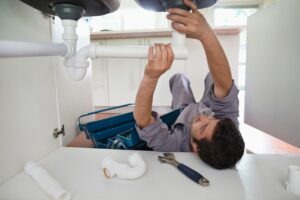How Much Do Plumbers Charge Per Hour?

*Updated May 15th, 2025
What Determines a Plumber’s Hourly Rate?
Like other skilled trade professionals, a plumber’s hourly rate is influenced by several key factors:
- Experience Level: The national average range for plumbers falls between $45 and $150 per hour. Master plumbers with decades of experience and specialized licensing command rates at the higher end of the scale. Apprentices and plumbers early in their careers charge less.
- Overhead Costs: Plumbers incur expenses for tools, work vehicles, insurance, licensing fees, and more. These overhead costs are built into hourly rates so plumbers can cover them and make a profit. Companies with larger fleets and more equipment generally have higher overhead.
- Supply Costs: Parts and materials are typically charged at retail rates on top of quoted labor rates. A basic supply markup averages 20% to 30%. Some plumbers offer discounts on supplies to keep jobs competitive.
- Emergency Fees: For after hours, weekend, or urgent calls, plumbers charge higher hourly rates due to overtime wages for their staff. If extensive troubleshooting is required, costs add up quickly.
- City/Region: In expensive metro areas and cities with high costs of living (like San Francisco or New York), plumbers charge at the upper end of the national range. Rates trend lower in less populated regions.
Flat Rate vs. Time & Materials Billing
When you request a plumbing service call, it helps to understand the two primary billing methods:
- Time and Materials Billing: The plumber charges by the hour for labor plus markup on parts/materials. This open-ended approach works well for extensive repairs requiring troubleshooting with an uncertain scope. Expect to pay a fair per hour wage plus supply costs.
- Flat Rate Billing: Best for routine service calls, plumbers quote a fixed upfront price for completing the identified work. Flat rate jobs typically range from $175 to $500 per project depending on complexity. This provides cost certainty but less transparency on labor rates.
Knowing whether a plumber charges hourly or by the job informs what questions to ask upfront. Be sure to request a written quote or estimate before authorizing expensive repairs or replacements. Reputable professionals stand behind their quotes and don’t surprise you with add-ons without consent.
Average Cost of Common Plumbing Jobs
Hourly rates are helpful, but let’s be real—most of us just want to know, “What’s this going to cost me?” To give you a better sense of what you might pay for typical plumbing jobs, here’s a breakdown of average price ranges based on national estimates. Keep in mind, actual costs can vary depending on where you live, the complexity of the job, and your plumber’s pricing model.
Unclogging a Drain: $100–$250
Got a slow-draining sink or a backed-up tub? A plumber can usually tackle it quickly with a snake or auger. The cost depends on the severity of the clog and where it’s located (shower drain vs. main line). The deeper the blockage, the higher the bill.
Toilet Installation: $150–$350
Whether you’re upgrading to a more efficient model or replacing a broken one, installing a new toilet isn’t super complicated for a pro. Labor typically runs a couple hundred bucks, and that’s before the cost of the toilet itself.
Water Heater Repair: $200–$600
If you’ve lost hot water, a plumber can usually repair a faulty heating element, thermostat, or pressure relief valve. Minor fixes are on the lower end, while bigger issues (or emergency service) can push things higher. If the unit is old, they might recommend replacement instead.
Burst Pipe Repair: $300–$1,000
A burst pipe is no joke—it can cause serious water damage in a short amount of time. The cost depends on where the pipe burst, how accessible it is, and whether drywall or flooring needs to be removed to get to it. Emergency service fees can also apply if it happens after hours.
Sewer Line Replacement: $3,000+
This is one of the big-ticket jobs, but sometimes it’s unavoidable—especially if your home has older pipes or frequent backups. Costs can climb quickly depending on the length of the line, depth of excavation, and whether trenchless technology is used. It’s a major project, but a necessary one for keeping your home safe and sanitary.
When Are Plumbers’ Services Worth the Investment?
Given the costs involved, is hiring a plumber worth it? In many cases, absolutely. Time and convenience are also important factors alongside labor rates when faced with a plumbing headache. Attempting DIY repairs often ends up more frustrating and expensive if problems worsen.
Plumbers have technical expertise, use specialized tools, and take safety precautions homeowners lack. You benefit by getting the job done right the first time. For extensive pipe replacements or sewer line repairs, the costs are unavoidable. Though for simpler tasks, consider your skill level and research whether DIY solutions exist.
In a plumbing emergency, rates become less of a concern. Mitigating water damage or restoring hot water take priority. When evaluating standard hourly rates for future maintenance visits, research multiple local plumbers to make cost comparisons. Request free estimates on labor and parts. And don’t assume chains necessarily equal savings. Many independent plumbers offer reasonable prices and great service too.
How to Save Money on Plumbing Services
Plumbing repairs can get pricey fast, but there are definitely ways to keep costs under control—without cutting corners. A few smart moves can save you time, money, and the headache of repeat problems. Here’s how to get the most bang for your buck when hiring a plumber:
Stay Ahead with Preventative Maintenance
The easiest way to save money on plumbing? Catch problems before they turn into big, expensive messes. Flush your water heater once a year to remove sediment buildup, check under sinks for leaks regularly, and don’t ignore slow drains—they’re often the first sign of a clog waiting to happen. A little attention now can help you avoid costly repairs later.
Bundle Repairs into One Visit
Got a leaky faucet in the kitchen and a running toilet upstairs? Don’t space those repairs out—have them fixed in one appointment. Plumbers often charge a flat service fee just to show up, so knocking out multiple issues during the same visit helps you get more value out of that trip.
Ask About Service Call Fees Up Front
Before booking, ask whether the plumber charges a service fee or diagnostic fee—and whether it gets applied to the total cost if you move forward. Some plumbers waive the fee if you hire them, while others don’t, so it’s good to clarify early on.
Always Get Multiple Quotes
It might feel like a hassle, especially during an emergency, but comparing a few quotes can make a big difference. Pricing can vary widely depending on the company, location, and even the time of day. Ask for a written estimate that breaks down labor, parts, and fees so you can compare apples to apples.
Handle Simple Fixes Yourself
Some minor plumbing jobs are totally DIY-friendly. Replacing a toilet flapper, unclogging a sink with a plunger, or tightening a loose faucet handle? Go for it. Just be honest with yourself about your skill level, and don’t bite off more than you can chew. A small mistake can turn a $20 repair into a $200 one—so when in doubt, call a pro.
Plumbing Maintenance Tips to Avoid Costly Repairs
Nobody wants a surprise plumbing bill—especially when it could’ve been avoided with a few easy habits. Staying on top of basic maintenance doesn’t take much time, but it can seriously extend the life of your pipes, fixtures, and appliances. Here are some low-effort tips to help keep your plumbing in great shape and your wallet happy.
Skip the Grease Dump
It might be tempting to rinse that bacon grease or cooking oil down the drain, but resist the urge! Once it cools, it hardens—and that gunk builds up inside your pipes like cholesterol in arteries. Instead, pour grease into a container and toss it in the trash. Your drains will thank you.
Insulate Pipes in the Winter
If you live in a colder climate, frozen pipes can become a real (and expensive) nightmare. A quick and affordable solution? Wrap exposed pipes—especially in basements, crawl spaces, or along exterior walls—with pipe insulation. It helps prevent freezing and bursting when temps drop.
Do a Monthly Leak Check
Get in the habit of looking under your sinks, behind the toilet, and around your water heater once a month. Look for puddles, moisture, or signs of corrosion. Catching a slow drip early can prevent mold, water damage, and major repair bills down the line.
Flush Your Water Heater Annually
Over time, sediment builds up inside your water heater tank, making it work harder and wear out faster. Flushing it once a year clears out that gunk, improves efficiency, and can help the unit last longer. It’s not as scary as it sounds—many homeowners DIY it, or you can ask a plumber to handle it during a routine check-up.
Conclusion
Plumbing issues aren’t fun, but knowing what plumbers charge—and why—can make the whole process a lot less stressful. Whether you’re dealing with a minor leak or a major emergency, understanding hourly rates and common cost factors helps you budget smarter and avoid surprises.
The next time you need a plumber, you’ll be ready to ask the right questions, compare quotes, and feel confident that you’re getting fair value for quality work. And remember: a little prevention and regular maintenance can go a long way in keeping plumbing costs down over time.
Additional Plumbing Resources
- Why Water Heater Maintenance Matters
- 8 Questions to Ask a Plumber
- How to Clean a Clogged Drain: A Complete Guide

Anna has over six years of experience in the home services and journalism industries and serves as the Content Manager at MyHomePros.com, specializing in making complex home improvement topics like HVAC, roofing, and plumbing accessible to all. With a bachelor’s degree in journalism from Auburn University, she excels in crafting localized, comprehensive guides that cater to homeowners’ unique needs. Living on both coasts of the United States has equipped her with a distinctive perspective, fueling her passion for turning any house into a cherished home through informed, personalized decision-making.








